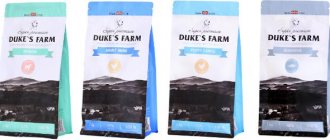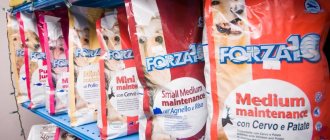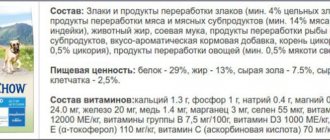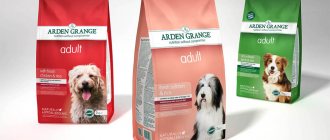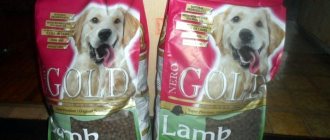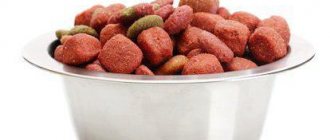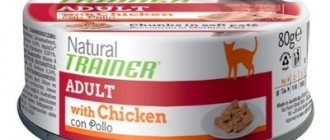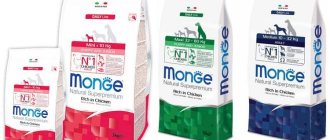Bosita dry dog food is produced in Sweden, where high-quality plant products are grown and fresh meat is used.
The company produces several lines of food, including dry food, namely Bozita economy class and Bozita Robur premium class. Both lines are represented by nine types of food intended for dogs of different ages and activity levels, as well as for pregnant and lactating bitches, dogs with sensitive stomachs and dogs prone to obesity.
Animal sources of protein
As the review of Bozita Naturals Original Adult Dog food shows, fresh meat ingredients were used in its production, namely 4% fresh chicken in the “Chicken (including fresh chicken * 4%)” component. This means that there is very little fresh chicken in the composition, and its inclusion in the composition rather resembles a marketing ploy - an attempt to improve the image of the diet in the eyes of the buyer.
There are four sources of animal protein in the food: chicken (including fresh chicken* 4%) - No. 2 in the list of ingredients, dried salmon * - No. 4, meat and bone meal - No. 5 and hydrolyzed chicken - No. 8.
There is so little of the last ingredient in the composition that it cannot be regarded as a complete source of animal protein. Rather, it is precisely a flavoring and aromatic component designed to make food more attractive to the animal.
The animal protein content of the feed is generally average.
Bozita food line
The range of the Bozita brand is very diverse and is regularly updated with new options. All food is divided into series that meet age and breed criteria, which is very convenient for obtaining nutrients in exactly the quantities that the animal needs at the current stage of life.
The range of the Bozita brand is very diverse.
Manufacturers also paid attention to the fact that animals will enjoy not only the variety of flavor solutions, but also the food supply. Therefore, dry and wet dog food systems have been created, which complement each other perfectly.
IMPORTANT. The Bozita regular food series includes products that can meet the nutritional needs of a dog at all stages of its life. The Bozita Robur series is designed for dogs that are exposed to high physical activity and expend a lot of energy. The Nordic by Nature series includes the best diets with natural ingredients from the Scandinavian pantry.
Food for puppies
Bozita food for puppies is specially designed to provide a complete diet during the period of active growth of babies. Here you can find a menu for puppies of all breeds, as well as for large breeds. In addition, puppy food is excellent for pregnant and lactating bitches, ensuring the former healthy development of the fetus, and the latter a good milk flow.
The Bozita Junior diet ensures a smooth transition from breast milk to dry food. Bozita Naturals Puppy & Junior food granules contain a lot of protein and essential nutrients necessary for the harmonious development of a growing pet. And the special formula of the Bozita Robur Breeder & Puppy diet most accurately meets the needs of large breed puppies.
Bozita diets for adult dogs
The Bozita line of dry dog food includes a considerable number of diets for adult dogs.
The Bozita line for adult dogs includes diets with a variety of flavor solutions.
Based on the characteristics of the breed and the health status of the pet, manufacturers have released several types of menus for adult dogs:
- with a normal level of activity;
- with an increased level of activity;
- with a low level of activity and overweight (for adult and elderly dogs);
- with sensitive digestion;
- picky eaters;
- prone to allergies.
The buyer can choose from a number of flavor solutions: chicken, lamb and rice, salmon and rice, chicken and fish, chicken and elk, chicken and venison, chicken and salmon, etc.
Bozita wet food
The manufacturer has not forgotten about the release of Bozita wet food, intended for dogs at all stages of their life. The line of wet food is represented by a huge number of pates and treats in the form of pieces in jelly.
Canned foods are also a balanced diet containing vitamins and minerals for the health of your four-legged friend.
Plant based protein sources
Ingredient No. 1 in the feed is wheat. This is perhaps the most undesirable of all possible grains in dog and cat food, which greatly reduces the ranking of Bozita Naturals Original dog food.
Corn sprouts are also partly a source of vegetable protein. In fact, these are corn germs, and not sprouted grains, as the name might suggest.
Since all these products are sources of vegetable protein and carbohydrates, the content of the latter in the feed is generally high. Note that grains are not included in the natural diet of carnivores, and therefore in large quantities, and especially as the basis of food, are not recommended for them.
Reviews from veterinarians about Bozita dog food
Marina, veterinarian, 41 years old. I can’t say anything bad about the Bozita brand of dog food. The food is complete and balanced, and is also made from environmentally friendly products grown in Sweden.
Veterinarians recommend Bozita food as the main diet for dogs.
This country is famous for the purity of its nature, healthy climate and high standards of animal welfare, so I have no doubt about the quality of Bozita products. The diets of this brand do not contain harmful additives in the form of flavor enhancers, flavorings, preservatives and other chemicals. They contain the optimal level of nutrients necessary for the healthy functioning of organs and systems, supplemented by a balance of fatty acids, lactic acid and a specially developed complex for the animal's immunity. I strongly recommend Bozita food for daily feeding of your pets.
Anatoly, veterinarian, 39 years old. Bozita brand food is of good quality and affordable price, so for many dog owners they are the best option. But you need to understand this: food of this brand can be both super-premium and premium, which means their composition and price are significantly different. For example, Bozita Robur series diets contain an increased percentage of meat (23-48%), glucosamine and chondroitin, specially processed barley grain and the natural immunostimulant Macrogard. Premium Bozita does not contain so many useful additives, and the percentage of meat varies between 19-34%. Both grades are free of soy, dyes and flavors. Of course, if you have the financial opportunity, I recommend buying super premium Bozita, but a cheaper option may be perfect for your four-legged friend.
Healthy Ingredients
Yeast* is a source of B vitamins, but it is not known which type is added to this diet.
The food also contains a component called “minerals”. They are added partly due to a lack of minerals and vitamins in the raw materials, partly due to the peculiarities of the technological process for the production of dry food (this is the industry norm, and therefore is not a direct indicator of high or low quality of the diet).
Natural antioxidants are special compounds, presumably vitamin E or rosemary and citric acid, that are added to prevent spoilage and rancidity of the diet.
Reviews from dog breeders about Bozita food
Alexandra. My Chihuahua is a very picky dog when it comes to ready-made food. He eats with pleasure what is on the table, but cannot get used to artificial nutrition. We bought many different brands: ProPlan, Eukanuba, Pedigri - wasted money.
Dogs happily eat both dry Bosit diets and canned food.
When they once again tried the Bozita brand pate, the dog ate with such an appetite as it had never seen before. Now, when it's time for lunch, he's literally shaking with anticipation for the treat. We buy Bozita in a tetra bag with chopped pieces of meat in jelly inside. The smell is very appetizing, as if it had just been cooked. Our dog has no health problems, so I continue to feed him with these foods.
Dilya. I am very pleased with Bozita food. My dog is from Sweden, and when I adopted her as a puppy five years ago, I was given this food as a gift. The breeder told me in detail about this food, that the manufacturing company has a huge farm and uses only fresh ingredients. They grow all their grains themselves, as well as their meat. At that time, these feeds were not available in Russia, but as soon as they appeared, I immediately began to buy only them. The dog eats both dry diets and canned food with great pleasure. There are no health problems. It’s a pity that they don’t supply canned moose to Russia; I really wanted to try it.
Advantages and disadvantages
- According to a study by Roskachestvo, Bozita food is recognized as safe and of high quality. No mycotoxins, E. coli, infectious agents or salmonella were found in it; no antibiotics, radionuclides or heavy metals. The amount of benzoic acid is within the limits established by Roskachestvo. There are no traces of foreign impurities (sticks, sawdust, garbage, metal shavings), there are no traces of pests of grain stocks.
- In Sweden it is prohibited to use growth hormones in animal husbandry, which means there is no need to worry about their presence in meat. The same applies to genetically modified animal raw materials: GMOs are prohibited.
- The MakroGard immunostimulant is a patented and harmless substance, absolutely natural. It strengthens the immune system and the body as a whole, reduces the risk of cardiovascular diseases.
- The percentage of crude fiber, protein and crude fat corresponds to the percentage indicated on the packaging and meets all standards.
- The amount of fats, proteins and carbohydrates is balanced.
- It is enriched with a rich complex of amino acids and vitamins: A, E, D, B2, B3, B6, potassium, zinc, selenium, sodium, manganese, magnesium, calcium. There are unsaturated fatty acids (such as arachidonic and linoleic).
- The taste of both dry and wet food does not deteriorate by the end of the shelf life (due to the good ratio of acidic and peroxide fats).
- There are no dyes or synthetic flavors in the composition.
- The assortment is large, food can be bought in many cities or ordered via the Internet directly from the manufacturers.
- There are traces of pesticides: permethrin and piperonyl butoxide. They could get into the feed either intentionally (as a protective agent against pests) or accidentally (along with plant materials). However, their number is not regulated by any standards, and this raises some concerns.
- The amount of potassium is higher than normal, and the amount of calcium also differs from the normal intake.
- It contains corn and wheat, and they are the strongest allergens, leading to diabetes and obesity.
- The composition contains cellulose, which does not provide any nutritional value, but is added solely for weight. It is also not specified what yeast is used.
- The line does not contain dietary food (for animals with sensitive stomachs), or treats.
- It is not clear what preservatives are used, since the packaging states vaguely “high-energy ingredients protected by EU-certified antioxidants.”
- Feed is expensive, so not every owner can afford to buy the product on a regular basis or even often.
- Users have noted many errors in Russian labels, which misleads users. For example, Cassia Gum is translated as “cinnamon gum,” but in reality it is cassia gum, a thickener.
Expert opinion
Dusheba Vera Ivanovna
In 2010, she graduated from the Moscow State Academy of Veterinary Medicine named after K.I. Scriabin with honors, specializing in veterinary medicine. I regularly attend veterinary conferences, congresses, and webinars.
Don't forget that dry food makes you very thirsty. And, even if your cat drank little before this time, then with a change in the menu she will begin to run to the drinking bowl more often. Make sure that her bowl is always filled with fresh water at a comfortable drinking temperature. Running water is saturated with oxygen, but not tap water (it contains too many compounds harmful to animals), but passed through a filter. Bottled water (from underground sources) will also work. But boiled water is not healthy!
Get acquainted with interesting cat breeds with the help of our encyclopedia: Scythian toy bob, Highland fold, Laperm.
Feed class
The manufacturer classifies its food as super-premium, however, in fact, it is not such for several reasons.
Firstly, due to the vagueness and imprecision of the wording (“dehydrated meat” may contain by-products, but this is not indicated).
Secondly, due to the presence of wheat and corn.
Thirdly, due to the meager presence of other useful components (from vegetables - only beets), from herbs - rose hips.
Therefore, we can safely classify the product as premium.
What do our visitors think?
PremiumSuper-premium
Packaging and cost
Available in bags of 1.5, 2, 3.5, 5, 12, 12.5 and 15 kg, depending on the specific dry food. Each food has a specific granule shape, so granules come in the shape of rings, triangles, hearts, as well as square, round, and rectangular shapes. For small dogs, granules are produced in small sizes in the form of balls.
The cost of a minimum volume Bozita package is about 400 rubles, and for 15 kg you will have to pay about 3500-3700 rubles. The cost of Bozita Robur is 1000-2000 rubles higher.
Unwanted Ingredients in Dog Food
Ekaterina Chistova, veterinarian at the VetLight veterinary clinic, graduate of the training programs of the North American Veterinary Society NAVC:
– Most often, the main components of dry food of the economy and premium classes are meat flour, cereals (corn), and chicken fat. Next come various additives, such as probiotics, yucca extract, vitamin and mineral premixes; preservatives, stabilizers, and anti-caking agents are added to certain brands of food.
The composition of wet food (also economy and premium segments) is meat or meat by-products (from 4 to 15%), various gelling agents, flavoring and other additives, a complex of fat-soluble vitamins (A, D, E).
Important
If the protein source is not specified in the composition, then there is every reason not to trust the quality of the product. The raw material for obtaining its animal proteins can be any waste from slaughterhouses and other places (for example, dead, euthanized or accident-dead animals).
As a rule, the composition of food in the “economy” segment contains such abstract components as cereals, meat and offal, and protein plant extracts. Again, whose meat and whose offal is not specified. The percentage is also unknown. It is best to avoid this food as the origin of the protein sources is unclear.
Ekaterina Nigova, veterinary nutritionist, clinical nutrition specialist at the Zoostatus clinic:
– By-products are the main source of some microelements and vitamins, which are either absent or very little in muscle meat. In fact, their content in feed can reduce the amount of other, artificial additives. On the other hand, offal contains a large amount of connective tissue, the digestibility of their protein is lower than that of muscle meat, so a high content of offal can negatively affect the completeness of the protein composition. Some dogs have difficulty digesting connective tissue (cartilage) and may experience diarrhea.
Ekaterina Chistova
continues to analyze the composition:
– Dehydrated animal protein
– dried protein from the soft tissues of unknown animals, most likely unsuitable for human nutrition. It is similar to meat and meat and bone meal, but has a much higher protein content. I would not recommend food containing dehydrated protein, because it is a product of deep processing of unknown animal raw materials of dubious quality.
Ekaterina Nigova
adds:
– Dehydrated protein is not suitable for animals prone to allergic reactions to various types of food, since the exact composition is unknown. For others, there is nothing particularly scary about this: as a source of protein, animal proteins are good in any case. On the other hand, the quality of dehydrated proteins can also vary, but it is basically impossible to check this from the label.
“In the feeds of the economic segment and some premium feeds you can find protein plant extracts or isolates of plant proteins,” explains Ekaterina Chistova.
If plant protein is listed as one of the first five ingredients in a food, it means it forms the basis of the diet. The introduction of vegetable proteins into the composition serves only one purpose - to reduce the cost of the product, but at the same time not violate the standards for protein content. Some manufacturers explain that they select plant proteins with maximum digestibility. But no matter how hard they try, such proteins are digested worse than animals - they are exactly what carnivores need. I believe that isolates and hydrolysates are not a beneficial ingredient in animal feed formulations. Good food should contain only high-quality animal sources of protein - meat, poultry, eggs, fish.
What additives are used?
Let's move on to a detailed analysis of the composition. Many super premium foods do not contain preservatives or dyes. Expensive foods use natural flavors (broths). Antioxidants and preservatives are more often used in cheaper foods; let’s look at these additives in more detail.
Antioxidants (antioxidants)
These substances interfere with the oxidation process. Typically, oxidation refers to the formation of reactive oxygen species (ROS), which includes free radicals and peroxides. They can cause damage to cellular components - proteins, lipids, DNA. For the human or animal body, this can be fraught with the development of diseases, including cancer, and for food products - spoilage. The presence of antioxidants in food, as a rule, is aimed at preserving its properties, but in some cases the additive provides some protection against the same free radicals in the consumer’s body.
- Thermox
acts as a mixture of antioxidants: protects fats, fat-soluble vitamins, carotene from oxidation. Helps prevent loss of quality of meat and bone or fish meal and finished feed. This increases shelf life and reduces costs. There are no side effects or complications associated with the use of Thermox.
- Tocopherol
(vitamin E) (E307). The feed most often includes α-tocopherol - it has the maximum biological activity. Prevents fat oxidation (including protecting fat-soluble vitamins) and thus protects food from spoilage. In addition to the beneficial effect on the food, it also has a positive effect on the consumer - in this case, your pet. Alpha tocopherol slows down the formation of free radicals in the body and at the same time protects cell membranes from damage, prevents the development of malignant tumors (especially effective in combination with vitamin C). Also promotes the absorption of retinol (vitamin A)
- Miko Carb
– a feed additive to prevent contamination of feed raw materials and compound feeds by mold fungi and pathogenic microflora during storage. No side effects or complications were identified when using this supplement (again, in regulated quantities).
Preservatives
- Potassium sorbate
(E202). Prevents the growth of molds and yeasts. Included in the list of the most popular preservatives. Numerous studies have been conducted showing that the additive can be considered harmless in doses not exceeding the maximum permissible norm. The allergenicity of the substance is extremely low. It has neither carcinogenic nor mutagenic effects on the body and is not a teratogen (that is, it does not affect the development of the embryo).
- Propyl gallate
(E310). An inexpensive preservative of artificial origin, which is used in the food industry to prevent fat oxidation. However, this additive is not so harmless - it is not for nothing that it was banned for use in the production of canned food and purees for baby food. There is evidence that propyl gallate can cause allergic symptoms (including asthma), stomach irritation, and liver and kidney problems. Studies on mice have shown that the compound can provoke the growth of cancerous tumors. We recommend avoiding dog and cat food if it contains this chemical.
- BHA
(English BHA)
is another antioxidant that does not promise anything good. Butylated hydroxyanisole is a chemical waxy substance obtained as a result of a chemical reaction. In feed it serves as a preservative and antioxidant, helping to preserve the color and taste of finished products. The attitude towards this preservative in different countries is ambiguous: in some it is prohibited for use in the food industry in whole or in part, while in others it is considered safe (in reasonable doses). This is due to differences in the results of studies on different animal species. However, it is better to avoid foods containing BHA.
Other components often found in food include:
- Sodium tripolyphosphate
(E451) – used in food production as a stabilizer, emulsifier and color fixative. Some manufacturers add this compound to dog and cat food to prevent tartar in them. It can interact with calcium in saliva, preventing plaque from hardening (which is why you can also find it in toothpaste). However, the effectiveness of its use for this purpose is questionable - the granule remains in the mouth of a dog or cat for too little time for tripolyphosphate to have its effect. On the Internet you can find many articles about the dangers of consuming products containing sodium tripolyphosphate, but research does not confirm this. There are two forms of the compound: food and industrial. Perhaps the fears arose due to confusion between the two. It should be noted that this substance is used in the food industry and is approved in Russia, the EU and the USA.
- Choline chloride
– a compound based on vitamin B4, an important element of cell membranes. It regulates fat metabolism and protects the skin from dehydration. Unfortunately, the animal body synthesizes it in insufficient quantities, so it is important to fill this gap. A lack of substance in the body negatively affects fat metabolism. This leads to a pathological accumulation of fatty acids in the animal's liver. Timely introduction of choline into the diet helps damaged liver cells recover.
- Taurine
– an important vitamin for the heart of both dogs and cats.
There are many other additives that do not provide any value to the animal. For example, palm or coconut oil, various herbs and berries are just a marketing ploy. Some foods contain salt, vegetable oil, and water.
Ekaterina Nigova:
– It is also worth noting liver hydrolysate. This is an approved flavoring additive. Many dogs like the smell of liver, so this compound can often be added to low-protein medicated foods (high protein is contraindicated for sick dogs) to make them more attractive.
Flavors
Ekaterina Chistova:
– Cats and dogs judge food by smell, and therefore flavorings can make it more attractive to them than it really is. It is somewhat more difficult to make a detailed review of this group of additives, since manufacturers, as a rule, do not disclose which flavoring substances they use - this is a company secret that determines commercial success. There are strict GOST standards for both feed and food flavorings - they include only approved additives. We wrote earlier that flavors, natural or artificial, are safe for health.
In light of this, it can hardly be said that flavorings somehow affect the pet’s body and can cause harm to it. Could their presence indicate a cheap, tasteless product that is masked by such an additive? More likely no than yes, but you should understand that the more different additives, the more economical the food. In more expensive and more natural feeds, the above additives are not used.
Ekaterina Nigova:
– Sometimes flavorings can really mask unpleasant odors - for example, tripe, which is a cheap component, contains poorly digestible protein and is usually not used for expensive feed or is used in small quantities.
Flavor enhancers
Ekaterina Chistova:
– This component may also be classified. According to available information, this additive is called C'SENS 9L and is supplied to Russia by SPF, the largest enterprise for the production of feed flavoring additives, whose main office is in France. Since the exact composition of C'SENS 9L is impossible to determine, and there is no reason to assume that it is natural, we would not trust such a food ingredient. Most likely, it is simply a complex of chemical flavors and taste attractants (substances that attract with their smell). Artificial flavor enhancers, especially those of unknown origin, should not be part of high-quality finished food. There is a risk that they can cause allergies in the pet, addiction to food, or accumulate in the body.
GMO
– Manufacturers of animal feed understand that GMOs cause distrust on the part of consumers, and avoid their use in feed – in most cases you will not find genetically modified organisms in the composition, – says Ekaterina Nigova
. – But you need to know that the proud inscription “No GMO” does not make animal food safer or healthier.
healthy ?
Ekaterina Chistova:
– Recent evidence suggests that grain-free foods may cause heart disease (cardiomyopathy) in dogs. Thus, most preservatives, stabilizers and other components are harmless and do not have any effect on the animal’s body. As a rule, feed is tested for increased dosages of individual substances, and if an excess is detected, the entire batch is recalled from sale. In addition, the use of excessive doses of preservatives and antioxidants is often technologically impractical and only increases costs.
What food can be called ideal?
Based on the composition, the first place should be the animal protein component in a high percentage (at least 30-40%), gluten (cereals) - no more than 5-8% of the total volume, animal fat - no more than 15-18%, omega -3 fatty acids – 3.9. But omega-6 is not beneficial for the animal body. An ideal food should not contain preservatives, flavors or antioxidants. It must be balanced in vitamin and mineral composition. But it is worth making allowances for the individual digestibility of different components, so it is better to select a diet for a specific pet with a specialist.
How does a dog owner choose food?
We asked a famous blogger how she chooses food for her pet and what she pays attention to.
Irina Goldman ,
best travel blogger according to Glamor magazine, owner of a husky named Space:
“Dry food is very convenient in case of frequent trips: when constantly traveling, it is inconvenient to take natural food with you or at least, so when traveling frequently, dry food becomes a salvation.
When choosing food, I primarily focus on its composition: the food should consist of the highest quality and natural ingredients and a minimum amount of by-products. As for starch and palm oil, they should not be present in high-quality food. It is also important for me to understand what kind of meat the food is made from. I also pay attention to the country of origin; at the moment I really trust Canadian and European feed.”
See the results of a study of dry dog food conducted by Roskachestvo HERE
How do you choose food for your pets? Leave your comments and ask questions on our website. Experts will answer you.
Be the first to know about new materials from Roskachestvo by subscribing to our newsletter .
